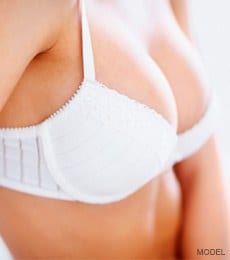Achieving The Perfectly Harmonious Breast
As an experienced plastic surgeon, my goal for every breast enhancement patient who's looking for the… Read On
Craig W. Colville, M.D., F.A.C.S
2865 North Reynolds Road #250
Toledo, OH 43615
Phone: (419) 534-6551
Monday - Thursday: 8:30 a.m.–5 p.m.
Friday: 8:30 a.m.–2 p.m.

Breast implants can be removed and, if desired, replaced during revision breast augmentation surgery. At his Toledo, Ohio, practice, Dr. Craig Colville specializes in revision procedures for women who underwent surgery elsewhere. Cases can range from older implants that need replacing to more complex issues needing correction. The vast majority of women are satisfied after getting breast implants, but complications and other circumstances sometimes require a secondary procedure.
Thorough pre-operative planning, discussion, and execution of breast augmentation surgery will lead to successful results in the vast majority of cases. Changes can occur over time, however, leading to the consideration to undergo revision surgery. Breast implant revision is an option if you have older implants that you wish to have replaced with more modern ones. Implant position or breast fold location may be corrected at this time. Some of the common reasons for revision surgery include:
Complications can also occur at any time, requiring correction. Either the breasts are uneven or asymmetrical or the implant isn’t correctly positioned. Other women notice changes in the shape, size, or volume of their breasts. Changes occur because of aging, weight fluctuations, or stretched skin.
General anesthesia is normally used when removing breast implants. Dr. Colville is generally able to use the original incision to insert the new implant, usually removing scar tissue from the original implant at the same time.
Complex breast implant revision surgery includes removing and replacing breast implants from a previous breast augmentation, often for reasons complicated by other factors. Sometimes patients do not wish to have their implants replaced, so Dr. Colville performs breast implant removal, which may include capsulectomy (removal of the capsule). Revision breast surgery is required for a number of reasons, including:
Improved augmentation techniques can now correct issues that were impossible to correct 10 years ago. Most, if not all, breast augmentation procedures performed decades ago inserted implants directly behind the breast glands, which is called a subglandular placement. This placement often caused problems, especially for the saline breast implants used at the time. Common problems included capsular contracture, implant rippling, and shifting implant position.
Today, Dr. Colville often recommends a submuscular placement for the implants. In this procedure, he inserts the implants not only behind the breast gland, but also under the pectoral muscle. This technique relies on the muscle for more natural coverage, and to better hold the implant in place while reducing the chances of capsular contracture, according to some studies. (The exact causes of capsular contracture are unknown at the present time.)
In some cases of capsular contracture, Dr. Colville recommends revision surgery with Strattice® — a natural matrix that helps support or reposition the implant or minimize the chances of recurring capsular contracture or other complications.

Dr. Craig Colville specializes in complex breast augmentation revision at his Toledo, Ohio, practice. In many cases, he uses Strattice reconstructive tissue matrix to help address specific problems, such as weak or inadequate breast tissue. The Strattice tissue matrix is approved by the FDA and is designed to support tissue regeneration. It is made of the same natural products widely used for years to repair and replace damaged tissues in other surgical procedures.
The tissue matrix is derived from porcine dermis. It’s a soft, natural product designed to reinforce weak tissue and support the growth of your own tissue. Since 2002, products such as the Strattice tissue matrix have been used in post-mastectomy breast reconstruction. They have also been used to treat surgical, trauma, and burn patients for more than 10 years.
Its use in revision procedures can help to:
Dr. Colville can use Strattice tissue matrix to help women who have undergone surgery elsewhere, and have complex breast issues including:
Bottoming out is a common complaint from women who have had breast implants for some time. Long after their breast augmentation surgery, some women experience a lengthened nipple-to-inframmamary fold distance — in other words, their nipples seem to have moved up on the breast. In reality, the breast pocket itself has dropped lower than desired, which stretches the skin beneath the breast. Breast skin laxity or the loss of skin elasticity may have also caused the breast to drop.
In the revision surgery, Dr. Colville attaches the tissue matrix internally to the inframammary fold and chest muscle, which can help support and position your breasts in the desired location.
When the fold below your breast (the inframammary fold) or the fold on the side of your breast (the lateral fold) moves, it’s called “fold malposition.” The form and defining borders of the breasts are affected by natural folds that should provide gentle curvatures under and on both sides of your breasts. These folds give the breasts definition and help maintain their shape and position.
After breast augmentation surgery, one or both breast pockets can be compromised by either the loss of skin elasticity or a breakdown of pocket boundaries, affecting either the inframammary fold, lateral fold, or both. Should this occur, the breast pocket may drift to the outside of your chest or appear to have dropped. They will no longer be in their original, desired position.
In breast implant revision surgery, Dr. Colville readjusts the breast pockets and re-establishes the inframammary and lateral folds. He then uses strips of the tissue matrix to redefine the fold location by supporting the fold repair inferiorly or laterally.
Breast implants can sometimes come too close to the midline of your chest, resulting in a condition called symmastia (sometimes called “bread-loafing” or “uniboob”) The natural space that exists between breasts is gone, leaving a woman without cleavage. Whether the breasts are naturally large or have been enhanced, there should be a degree of separation to give each breast definition.
Symmastia can occur following breast augmentation surgery if:
The Strattice tissue matrix can help support the repaired or newly created medial fold. During the breast implant revision, Dr. Colville will use the tissue matrix to reinforce existing weak or inadequate tissue, which may help provide additional support to hold the breast pocket in the desired location.
Wrinkling and rippling can occur when the skin is stretched too thin or when the breast pocket exceeds the optimum size needed. Also, if your breast implants migrate out of their original position because the breast pocket is too large, the appearance of rippling may occur. Rippling also commonly results when breast implants are too large and they “bottom out.”
The quality of the skin that envelops the breast tissue significantly influences the shape of your breasts. Even though your breast skin contains special elastic fibers, there is natural and hereditary variation in the amount of elasticity and thickness of each person’s breast skin, and this affects the overall appearance of your breasts.
Dr. Colville places the tissue matrix at the bottom of your breasts to reinforce weak or inadequate tissue. This can help support and position your breasts in the desired location, reducing the presence of wrinkles and ripples on the skin surface.
Capsular contracture is an unpredictable condition that may occur when scar tissue that naturally forms around your breast implants continues to increase in thickness. As thickness increases, it squeezes the breast, causing tightness, firmness, and changes in the appearance of your breasts. The condition may occur in one or both breasts and may vary in degree and severity. Discomfort and changes in breast appearance may require additional surgery. There is currently no known cause for this condition. The only known solution is to remove the capsule and replace the implants, sometimes in a newly created pocket.
If you have questions about your implants, or are considering replacing your implants with newer ones, request a consultation online to meet with Dr. Colville or call (419) 534-6551 to schedule an appointment. He serves revision breast augmentation patients from Findlay and Sandusky, OH, as well as Ann Arbor, MI.
"My ultimate goal is to design a plan accommodating your wishes and desires in the most aesthetically pleasing manner possible."
Meet Dr. ColvilleThe frequency of breast augmentation revision surgery varies, but studies suggest that around 20-25% of women who undergo breast augmentation may require revision surgery within 10 years due to various factors such as implant rupture, capsular contracture, or changes in personal preferences.
Breast implant revision surgery can be more complex than the initial surgery because it often involves dealing with scar tissue, thinner skin and stretched tissues, correction of deformity, repair or reinforcement of the implant pocket, and other concerns. The complexity of the revision surgery depends on the individual’s unique situation and the specific changes desired.
The level of pain experienced during breast augmentation revision can vary from person to person. While discomfort and soreness are common after the surgery, the pain is usually manageable and can be controlled with prescription pain medication. The recovery period should be similar to the initial augmentation procedure.
The timing for a breast augmentation revision surgery depends on various factors, including the reason for revision and the complications involved. In general, it’s a good idea to wait at least 6 months from your initial procedure for your final results to take shape.
Breast augmentation revision surgery, like any surgical procedure, carries potential risks and complications. However, when performed on a healthy individual by a skilled and experienced plastic surgeon, the procedure is considered quite safe.